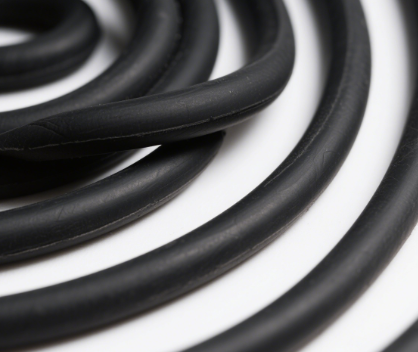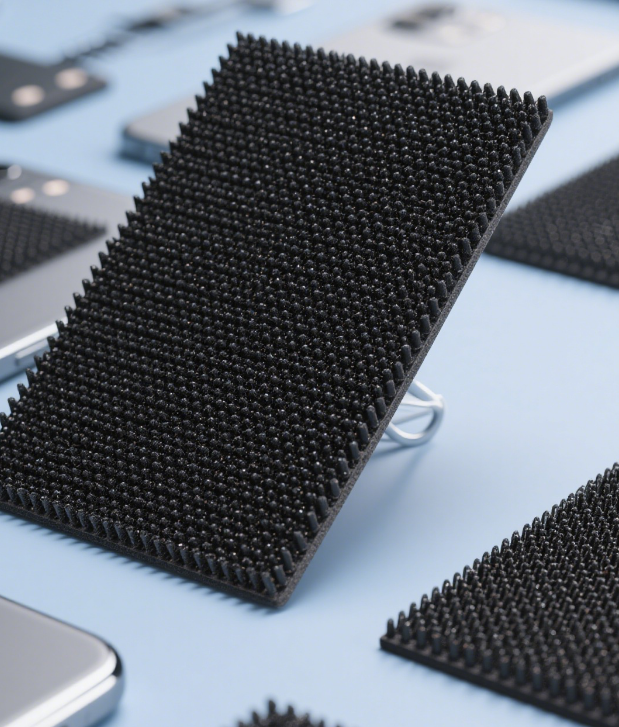conductive rubber for thermal management
2025/04/17
0
Thermal management conductive rubber is a high-performance composite material that integrates the functions of heat conduction, electrical conductivity, sealing, and electromagnetic shielding. Its core lies in achieving multi-dimensional performance synergy through filler design and process optimization. The following provides an in-depth analysis from aspects such as material design, key technologies, application scenarios, and future trends:
- Material Design and Performance Optimization
- Innovation of the Filler System
- Metal-based Fillers: Metal powders such as silver and silver-plated copper achieve a low resistivity (e.g., 0.002 Ω・cm) by forming a conductive network. However, they have the problems of easy oxidation and high cost. Silver-plated aluminum fillers have both electrical conductivity and the ability to resist salt spray corrosion, making them suitable for outdoor equipment.
- Carbon-based Fillers: Graphene (with a theoretical thermal conductivity of 5150 W/m・K) and carbon nanotubes (CNT) enhance the thermal conductivity by constructing a three-dimensional heat conduction path while maintaining light weight.
- Ceramic Fillers: Ceramic particles such as boron nitride (BN) and aluminum oxide (Al₂O₃) can increase the thermal conductivity to above 3.0 W/m・K. They also have high temperature resistance and good insulation properties, making them suitable for high-frequency electronic devices.
- Mechanism of Synergistic Effect
- Filler Blending: The combination of graphite and carbon fiber can increase the thermal conductivity of the composite material by 40%. Through the “heat conduction bridging” effect, the interfacial thermal resistance is reduced. When magnesium oxide and carbon black are used synergistically, the former enhances the rigidity, and the latter optimizes the conductive network, increasing the tensile strength of the rubber by 20%.
- Interface Modification: Silane coupling agents (such as KH-550) can improve the interfacial bonding between the filler and the rubber matrix. For example, after the acidification treatment of graphene, its dispersibility in nitrile butadiene rubber is enhanced, and the thermal conductivity is increased to 1.8 W/m・K.
- Typical Application Scenarios
- New Energy Vehicles
- Battery Thermal Management: High thermal conductivity silicone rubber (with a thermal conductivity of 3.5 W/m・K) is used to ensure the stability of the battery pack in an environment ranging from – 40℃ to 125℃.
- Motor and Electronic Control: Conductive rubber gaskets are used for the inverter housing. They not only shield electromagnetic interference (EMI) but also conduct heat to the water cooling plate, reducing the thermal resistance by 30%.
- Consumer Electronics
- 5G Base Stations: Conductive foam achieves electrical conductivity in the X, Y, and Z axes, with a low compression stress of up to 0.15 MPa, suitable for heat dissipation and shielding of millimeter-wave antennas.
- Laptop Computers: 3M’s self-adhesive rubber tape (such as 130C) is used for interface filling between the CPU and the heat dissipation module, with a thermal conductivity of 1.5 W/m・K, and the thickness can be customized to 0.5 mm.
- Aerospace
- Satellite Thermal Control: The spiral tube gasket maintains low volatility (TML<0.15%) in a vacuum environment, with a thermal conductivity of 5.0 W/m・K, and is used for heat conduction and electromagnetic shielding of electronic equipment in spacecraft.
- Aircraft Sealing: The FIP conductive rubber achieves both airtightness and electrical conductivity on complex curved surfaces through in-situ forming technology, with a temperature resistance range from – 60℃ to 200℃.
III. Industry Challenges and Future Trends
- Core Challenges
- Cost Control: Precious metal fillers such as silver powder account for more than 60% of the material cost. Nickel-coated copper powder gradually replaces silver-plated fillers due to its cost-performance advantage.
- Long-term Stability: Metal fillers are prone to oxidation in a humid and hot environment. Graphene/boron nitride composite fillers enhance the weather resistance through a multiple cross-linking network.
- Technological Frontiers
- Self-healing Materials: The composite film achieves reversible adhesion and crack repair under near-infrared light control, with a shielding effectiveness of up to 80 dB.
- Degradable Design: Lignin-based rubber elastomers achieve biodegradation and photothermal conversion through a dynamic cross-linking network, suitable for environmentally friendly electronic devices.

















